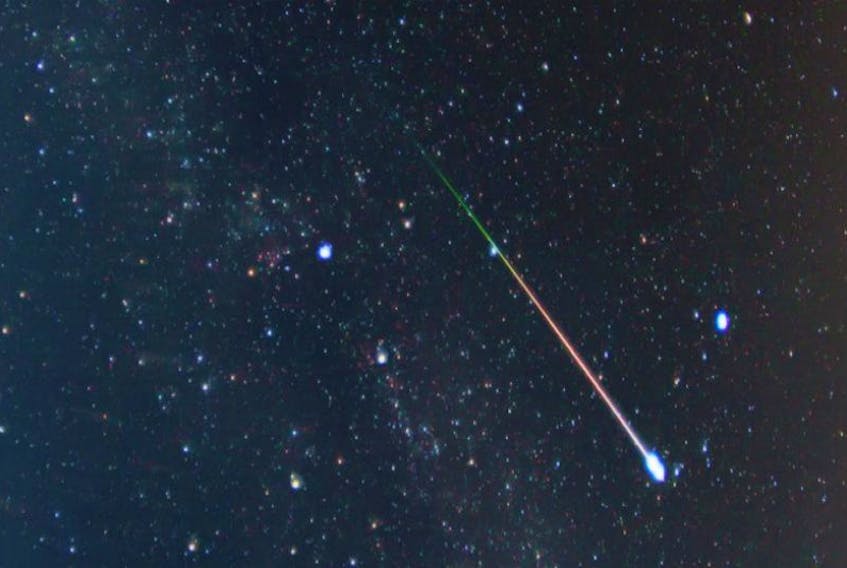The summer's premier (and one of the year's best) meteor shower - the Perseids - will peak during the evening/pre-dawn hours of Aug. 12-13.

This is when the Earth, in its orbit around the sun, intercepts the Perseid meteor stream. Unfortunately, as is sometimes the case, the moon interferes, as will the waxing, gibbous moon this time around. All is not lost though, as this shower is known for its bright fireballs; the possibility of seeing several streak across the night sky, even as the moonlight washes out the majority of fainter meteors, is quite good.
The Perseid meteor shower's radiant (apparent point of origin in the night sky) lies in the constellation of Perseus - the Warrior Prince, which during mid-August clears the northeast horizon around 10 p.m., and is directly overhead (the zenith; usually when the most meteors are observed) around 4 a.m.
The Perseids are debris associated with Comet Swift-Tuttle, a comet which was discovered in 1862 by astronomers Lewis Swift and Horace Tuttle, and which has an orbital period of approximately 133 years. The Perseid shower is usually a very reliable and prolific meteor shower, with a zenith rate (under a moonless sky, and from a dark site) of about 100+ meteors per hour. The shower itself actually lasts from around July 17 until Aug. 24, so it will still be possible, on any clear night, to catch sight of some of the later Perseids after they peak on Aug. 12 and 13.
To see the greatest number of Perseids, start watching the night sky as soon as it turns dark. You may see some meteors skim across the Earth's upper atmosphere. If possible, try to put a tall object - like a tree or a building - between you and the moon. The best, and most comfortable, way to observe any meteor shower is to lie on a blanket on the ground or a lounge chair, with a pillow behind your head, and an extra blanket to keep the late night/early morning chill and mosquitos at bay. If you place the northeast horizon behind you, you stand the best chance of maximizing the number of meteors seen, as the meteors will be radiating out across the sky from that direction. Of course, the later you stay up, the higher the Perseus constellation will rise in the night sky, until the radiant is directly above you around 4 a.m. The meteors will then radiate downwards, streaking towards all points of the horizon.
For anyone interested in the night sky, the Perseids are a favourite rite of summer, given the fact that a great many people are usually camping out during August, the weather is almost always warm, and the night sky above is usually clear (and moonless). Some of my fondest memories of when my children were young, were the summer nights we spent together lying on the beach late at night in the PEI National Park, observing the Perseid meteor shower. Wrapped in sleeping bags, we would ooh and ahh as each bright meteor streaked across the sky, until, as the eastern horizon began to lighten and Perseus faded from into the brightening sky, we drifted off to sleep to the sound of the waves gently rolling against the shore.
My kids often recall those magical nights when I mention that the Perseids are coming. It is a legacy that they will, I'm sure, pass along to their young children in the coming years. Though I may not be with them then, I know, as they lie there with their youngsters oohing and aahing at the "shooting stars", they will think of me; I am content with that.
While waiting for the Perseids to arrive, there is still much to see in the night sky. In addition to the many bright stars and constellations, two bright planets are visible during the coming weeks. Even the waxing moon will not wash out glorious Jupiter shining high in the south-west sky as the early evening sky darkens. Binoculars will show the four largest Galilean moons - Io, Europa, Callisto, and Ganymede - circling Jupiter.
If you are unsure which object is Jupiter, look for the brightest point of light just under and slightly to the right of the waxing, gibbous Moon on the night of Aug. 9. Jupiter remains visible almost the entire night, not setting in the south-west until the pre-dawn hours.
The bright, reddish star to the lower right of Jupiter is Antares ("Rival of Mars"), the heart-star of Scorpius - the Scorpion.
Though the ringed planet shines only at mag. +0.2 (10 times fainter than Jupiter's mag. -2.4), Saturn is still readily visible to the far left of Jupiter in the southern sky as it darkens. On the evening of Aug. 11, Saturn (still in the "teapot" asterism of Sagittarius - the Archer) sits immediately to the left of the near-full, gibbous moon. Like its larger sibling, Saturn stays up until the pre-dawn hours.
Having made its inferior conjunction with the sun last month, Mercury has transitioned from the evening sky to the morning sky. It should be visible above the east-northeast horizon about an hour before sunrise during the middle two weeks of August, though it will be too close to the Sun to be readily visible during the month's final week.
On Aug. 9, Mercury reaches its greatest western elongation (angular distance from the Sun as seen from Earth), and highest point in the pre-sunrise sky. Incidentally, when Mercury made its inferior conjunction between the Earth and the sun on July 21, it passed south of the sun's disk. When it makes its next inferior conjunction in November of this year, Mercury will actually transit (pass) across the sun's surface as seen from Earth. More on this rare event in November.
As they have for the past two weeks, Venus and Mars remain lost from view in the glare of the sun this month.
Until next time, clear skies.
Events:
Aug. 7 - First Quarter Moon
9 - Mercury at greatest western elongation
12/13 - Perseid meteor shower peak
15 - Full Moon
17 - Moon at apogee (furthest from Earth)
Glenn K. Roberts lives in Stratford, P.E.I., and has been an avid amateur astronomer since he was a small child. His column, Atlantic Skies, appears every two weeks. He welcomes comments from readers at [email protected].
READ MORE ATLANTIC SKIES









